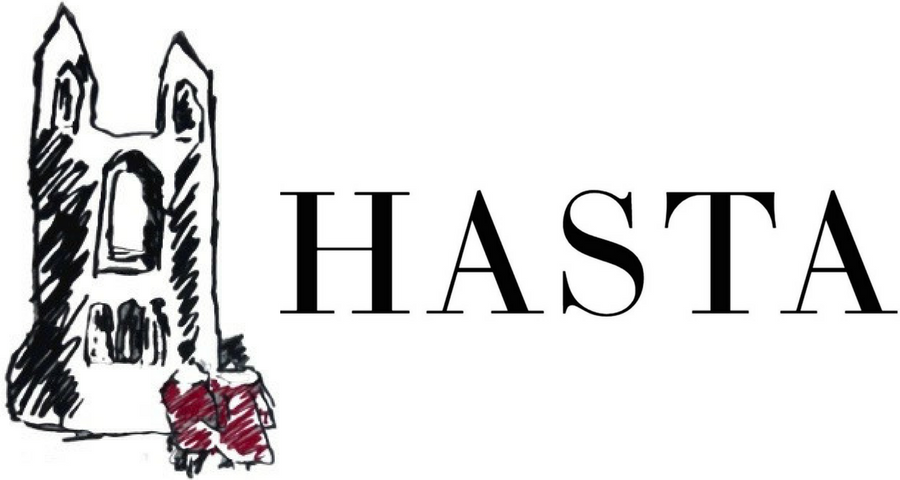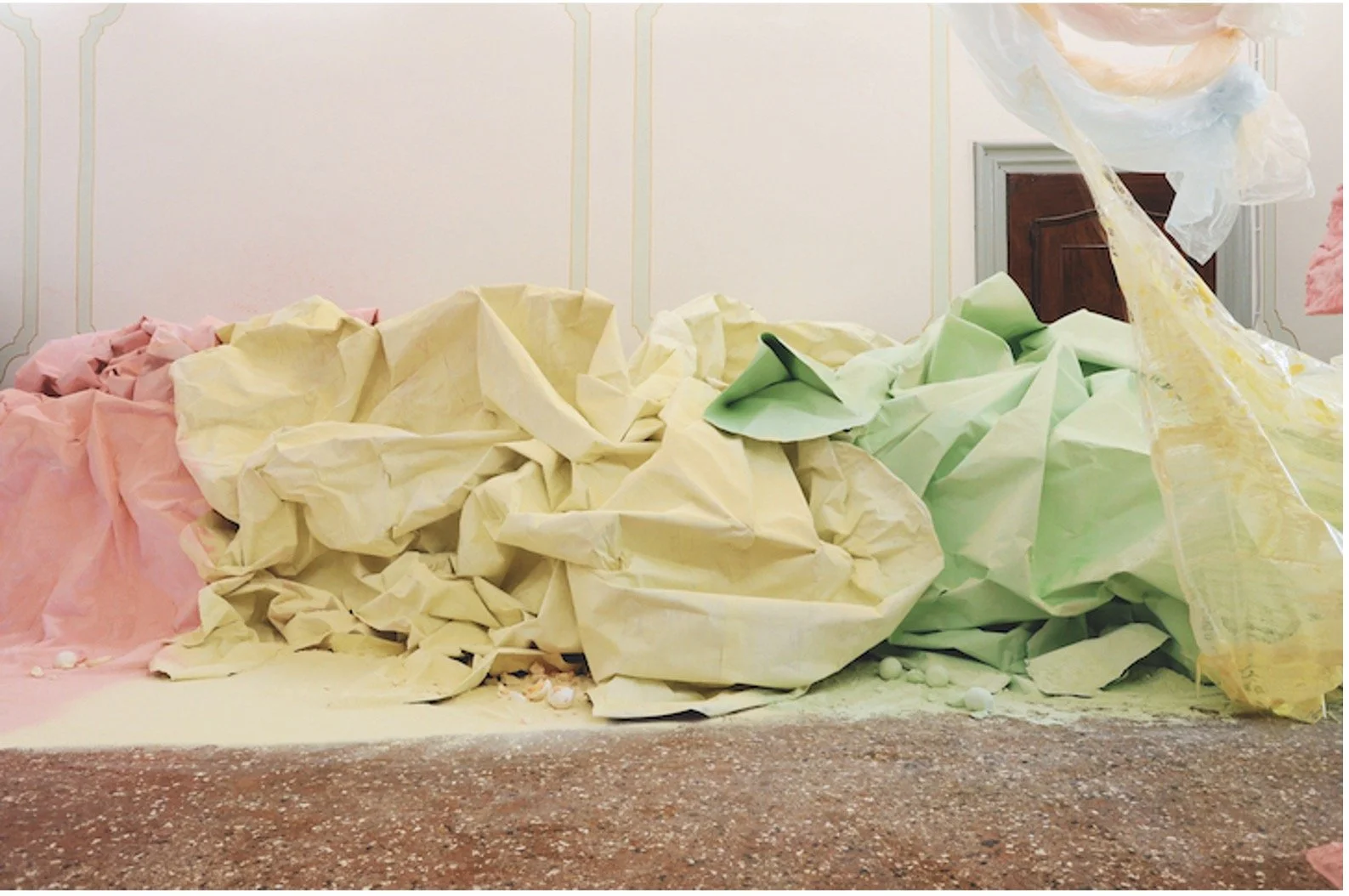Materials Over Meaning: The Sculptures of Karla Black
By Natascha Watt
Sculptor Karla Black works with materials that she likes, that appeal to her both visually and tactually. This philosophy lies at the heart of her artistic practice. Black uses simple materials that she can easily get her hands on, such as paper, cellophane, make-up, or bath bombs. Her interest lies in the materials themselves, contending that people cannot draw or project meaning out of and onto her sculptures.
Born in 1972 in Alexandria, West Dunbartonshire, Black attended Glasgow School of Art from 1995 to 1999 where she studied sculpture. Subsequently she gained a Master of Philosophy in Art Organisational Contexts (1999-2000) and a Master of Fine Arts (2002-2004) from the institution. She lives and works in Glasgow.
Karla Black, Principles of Admitting, 2009. Plaster powder, colour pigments, make-up ingredients and crushed brown sugar paper. Site-specific, dimensions may vary (this version: over 300 m2). Installation view, Migros Museum of Contemporary Art, Zurich.
Image courtesy of National Galleries of Scotland.
Her interest in different materials, including some that one would not necessarily expect to be used in sculpture, is interwoven with an interest in early childhood and play. Black draws inspiration from Austrian British author and psychoanalyst Melanie Klein’s writings, which examine the impacts of early life, like the experience of being on the floor as a baby or young child. Furthermore, Klein advocates a “play technique” instead of using language to analyse how children experience the material world. In accordance with this, Black’s pieces cover the ground but are also spread across walls or hung from the ceiling. Black plays with horizontality and many of her works cover vast expanses of the floor in a gallery space, as seen in Principles of Admitting (2009). In this piece, she covered the floor with blue paster powder, adding some crushed brown sugar paper. It can be read as drawing inspiration from the grids and gentle geometry in works by artists like Agnes Martin or Jasper Johns. In fact, Black herself has talked about her artistic influences spanning from the 1950s to the 1970s. She explains how, during those years, sculpture as a medium exploded and transformed into land art, happenings, or installations and how this inspires her. However, for her, aesthetics get lost in such Post-Modernist developments and so she aims to draw inspiration from them while taking them back to what she calls “the careful aesthetics of modernism”.
As noted by art historian and artist Ferren Gipson, since the 1960s, artists (especially women) have challenged canonical understandings of sculpture, working with softer materials, thus expanding the field of what one would consider sculpture to be. The everyday materials Black uses are processed in a way that leaves their original form unrecognisable. She is adamant that there is no referential meaning in her works but insists upon the fact that they are sculptures. She usually uses pastel colours in them and aims to appeal to all senses.
Furthermore, she takes into account the space her sculptures will be exhibited in when creating them. For her, it is crucial to do this as she believes the conditions a work operates in necessarily become a part of the work itself. When making a sculpture, she considers where the doors are, how high the ceiling is or how people will move around the room it will be exhibited in. As previously mentioned, she rejects the idea that her pieces have any meaning, rather advocating for the fact that they have real physical consequences in the material world. She says that art is chaotic, that institutions find it difficult to deal with the messiness of artistic creation. This is what she is hoping to insert into institutions, museums and the art market – which she refers to as “civilised contemporary society” – through her pieces. By freezing the messy moment of artistic creation in her sculptures, they come to physically embody what they are rather than symbolise any exterior thing.
Karla Black, Installation view (detail) of the exhibition At Fault, 2011. Mixed media. Palazzo Pisani, Venice.
Image courtesy of Art UK.
In 2011 Black represented Scotland in an exhibition parallel to the Venice Art Biennale, also being nominated for the prestigious Turner Prize that year. Scotland has staged its own “collateral” exhibitions to the official British Pavilion at the Biennale through the Scotland + Venice project, aimed at promoting Scottish art on the international stage, specifically by staging exhibitions during the Venice Biennale. This has proven to be an important space for Scottish artists to come to prominence. The exhibition of Black’s work was curated by The Fruitmarket, Edinburgh, where she subsequently held the first exhibition to follow renovations which took place in 2021. The works presented in Venice were made out of large bundles of sugar paper that had been either sprayed with fake tan and eyeshadow-stained balsa wood or chalked over with pastel tones. Other works presented were made up of soil scattered on the floor and oversized Lush soap cubes, thus allowing for an entirely sensory experience.
Karla Black, Story Of A Sensible Length, 2014. Polythene, powder, plaster, paint and thread. 300 x 300 x 300 cm. Installation view, GENERATION: 25 Years of Contemporary Art in Scotland, Scottish National Gallery, Edinburgh.
Image courtesy of National Galleries of Scotland.
In 2014, Black participated in the exhibition GENERATION: 25 Years of Contemporary Art in Scotland for which she made Story Of A Sensible Length, a soft and airy piece that hangs in space. Her inclusion in this exhibition once more reasserted her place in the Scottish art scene.
Bibliography
e-flux Announcements. ‘Karla Black – collateral event of the 54th Venice Biennale.’ 4th June 2011. https://www.e-flux.com/announcements/35486/karla-black-collateral-event-of-the-54th-venice-biennale
Gipson, Ferren. Women’s Work: From feminine arts to feminist art. Frances Lincoln, 2022.
Harbourfront Centre. “Interview with Karla Black.” Video interview, January 8th 2019. 5 min., 2 sec. https://www.youtube.com/watch?v=DxHkvffZlpQ&t=1s
Higgins, Charlotte. “Karla Black at the Venice Biennale: ‘Don’t call my art feminine’.” The Guardian, 1st June 2011. https://www.theguardian.com/artanddesign/2011/jun/01/karla-black-at-venice-biennale
Kunstraum Dornbirn. “Karla Black 27 June – 2 November 2025.” Accessed October 27, 2025. https://www.kunstraumdornbirn.at/en/exhibition/karla-black
Modern Art. “Karla Black.” Accessed October 27, 2025. https://www.modernart.net/en/artists/karla-black
National Galleries of Scotland. “Karla Black.” 19th October 2019. https://www.nationalgalleries.org/art-and-artists/features/karla-black



